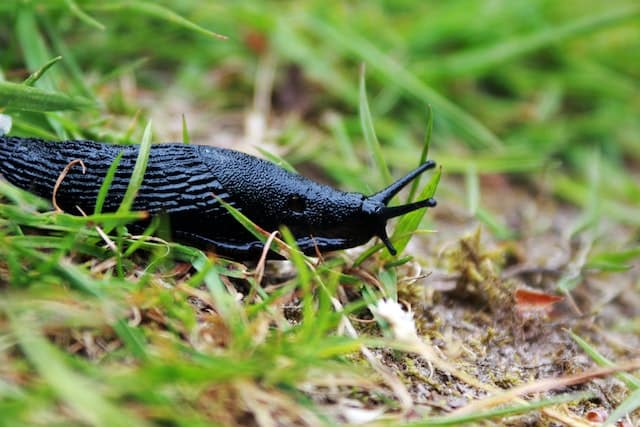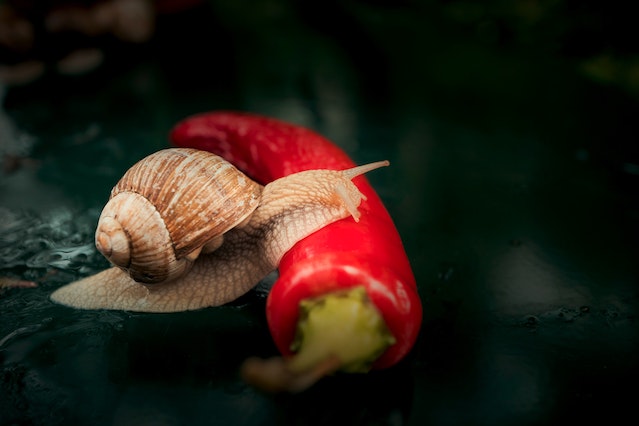Slugs and snails both belong to the class Gastropoda, and they are known for their slow movement and similar appearance. But is there a difference between a slug vs snail?
Snails are among the majority of gastropods that have a spiral-coiled shell for their body can retract when threatened. Slugs are naturally without any shell, which is a distinctive feature that differentiates a slug from a snail.
Both slugs and snails have over 60,000 different species. And some species of snails are very toxic.
Stay with us as we discuss the key differences between a slug and a snail.
What Is a Slug?
The word “Slug” is generally used as the common name for gastropod molluscs without a shell. Slug or land slug is a name commonly used for any apparently terrestrial gastropod mollusc without shells, or only with a small internal shell.
Many people are familiar with the land slug but not many know about sea slugs. There are also sea slugs that are found in the sea.
There are some land slugs that are more closely related to snails than other slugs. They form part of various different evolutionary lineages. These types of slugs are referred to as semi-slugs, with shells they are no longer able to retract into like a normal snail would.
Both slugs and snails move with a slime trail.

Also Read: Cockroach vs Beetle: Difference and Comparison
What Is a Snail?
Snails are among the majority of gastropods that have a single coiled shell they can retract their body into. The name “Snail” is usually applied to terrestrial pulmonate gastropod molluscs.
The name “Snail” is also used generally to include not just land snails but the different species of sea snails and freshwater snails. Some of the species of sea snail are very venomous, especially the cone snail.
Gastropods without shells or with an internal shell are called slugs, while land snails with very small shells that they cannot retract into are called semi-slugs.

Slug vs Snail: Types of Slugs and Snails
Types of Slugs
Naturally, there are over 60,000 species of slugs.
A few species of slugs commonly found in gardens include;
- The brown-banded Arion
- Black greenhouse slug
- European red slug
- Marsh slug
- Native reticulated slug
- Thread band slug
- Banana slug
- Spanish slug
- European black slug
- Large spotted garden slug
- Dusky slug
- Milky slug, etc.
Types of Snails
With over 5,000 different species, snails are classified into three main groups.
- Land snail: For the land snail, there are species like the giant African land snail, white-lipped snail, Croatian cave snail, Roman snail, Mediterranean green snail, white garden snail, candy snail, and milk snail.
- Freshwater snail: The freshwater includes species like Channeled apple snail, red nerite snail, mystery snail, golden apple snail, Columbia ramshorn apple snail, and rabbit snail.
- Sea snails: These are subdivided into periwinkle snails, geography cone snails, common whelk, hairy tritons trumpet, sea butterfly, and violet sea snails.
Also Read: Lice vs Tick: Difference and Comparison
Slug vs Snail: Anatomy
A distinctive feature that differentiates a slug from a snail is the coiled shell that snails can retract into.
According to UConn’s Home and Garden Education Center, most snails and slugs are hermaphrodites. This means slugs and snails have both the male and female reproductive organs.
However, slugs and snails still have to find others to mate with for them to lay eggs. It only takes a few days before they start laying eggs under a log or in moist soil.
Unlike snails, slugs are naturally without shells they can retract into when threatened. Some slugs use an internal shell that is not as protective as that of a snail.
Slug vs Snail: Speed
One of the similarities between slugs and snails is their very slow movement. But one is naturally faster than the other by the smallest margin.
A snail can close a tiny distance of one millimetre per second. This movement is faster than most slugs that hardly move a millimetre.
The species of slugs that hardly move at all are found at the bottom feeding on plankton.
Slug vs Snail: Habitat
Slugs and snails naturally live in habitats such as salt and freshwater and they love moist habitats as well. Anywhere from tree bark, moss, rotting logs, and piles of damp refuse is a comfortable environment for slugs and snails.
They both prefer dark areas and they mostly feed at night. They like to feed on different kinds of plants and leaves. You will find them feeding on decaying vegetable materials.
Slugs and snails avoid moving during the day because of the drying effect caused by sunlight. Slugs are without shells, so they use wooden boards, loose tree bark, and stone slabs to stay alive.
Also Read: Pug vs Bulldog: Difference and Comparison
Slug vs Snail: Comparison Chart
| Slug | Snail | |
| Definition | The word “Slug” is generally used as the common name for gastropod molluscs without a shell. | Snails are among the majority of gastropods that have a single coiled shell they can retract their body into. |
| Kingdom | Animal (Animalia) | Animal (Animalia) |
| Shells | Naturally without an exterior shell. May have a small internal shell. | Presence of a large coiled exterior shell- large enough for the snail to retract into. |
| Class | Gastropods (gastropoda) | Gastropods (gastropoda) |
| Lifespan | 1 to 6 years | 2 to 3 years in the wild and 10 to 15 in captivity. |
| Speed | Based on the particular species of slugs, sea slugs rarely move at all. | Speed can naturally differ but the common snail can move up to one millimetre per second. |
| Movement | They move at a slower pace compared to a snail. | Observing them closely, snails may appear to be moving on many feet. But it’s only the contraction of their muscle as they only use a foot. |
| Environment | Slugs prefer dark areas and they mostly feed at night. They like to feed on different kinds of plants and leaves. They prefer wooden boards, loose tree bark, and stone slabs to stay alive. | Snails can live in habitats such as salt and freshwater and they love moist habitats as well. Anywhere from tree bark, moss, rotting logs, and piles of damp refuse is a comfortable environment for snails. |
Slug vs Snail: Cuisine
Snails are a source of food in several countries worldwide.
For example, Escargot is a dish commonly associated with French cuisine consisting of edible land snails. Land snails are highly nutritious, which is why they are used for the dish.
On the other hand, marine snails can be quite venomous, especially the cone snail. It’s best you avoid eating any sea snails and only stick to land snails.
However, before you consume any land snail or slug, make sure you cook them thoroughly to kill off any form of parasite.
Yes, slugs and snails sometimes carry parasites that can be harmful to humans.
Also Read: Genotype vs Phenotype: Differences and Comparison
Conclusion
Snails are among the majority of gastropods that have a spiral-coiled shell for their body can retract when threatened. Slug or land slug is a name commonly used for any apparently terrestrial gastropod mollusc without shells, or only with a small internal shell.
One of the similarities between slugs and snails is their very slow movement. But one is naturally faster than the other by the smallest margin.
A distinctive feature to differentiates a slug from a snail is the coiled shell that snails can retract into.
Recommendations
- Sleep vs Rest: Difference and Comparison
- 5w20 vs 5w30: Difference and Comparison
- Family Medicine vs Internal Medicine: Difference and Comparison
- AKA and Delta: Difference and Comparison
- Faculty vs Staff: Difference and Comparison
References
- A-Zanimals: Slug vs Snail: The 3 Key Differences Explained
- Escargot-world: What is a Slug: Essential Guide to Understanding This Friendly Mollusk
- Homegarden.cahnr.uconn.edu: Slugs and Snails
- Wikipedia: Snail
- Wikipedia: Slug

Leave a Reply